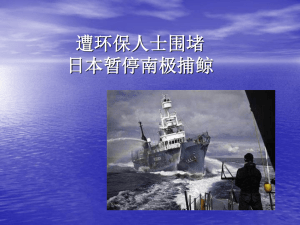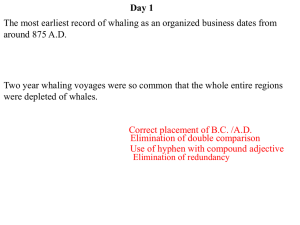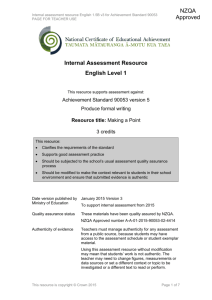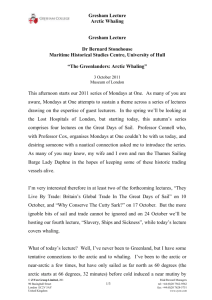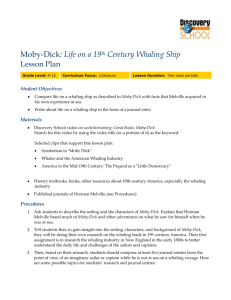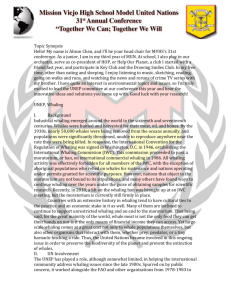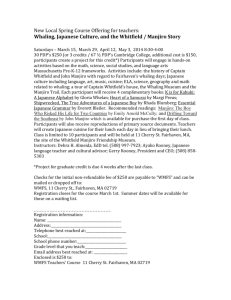Before - RegOnline
advertisement
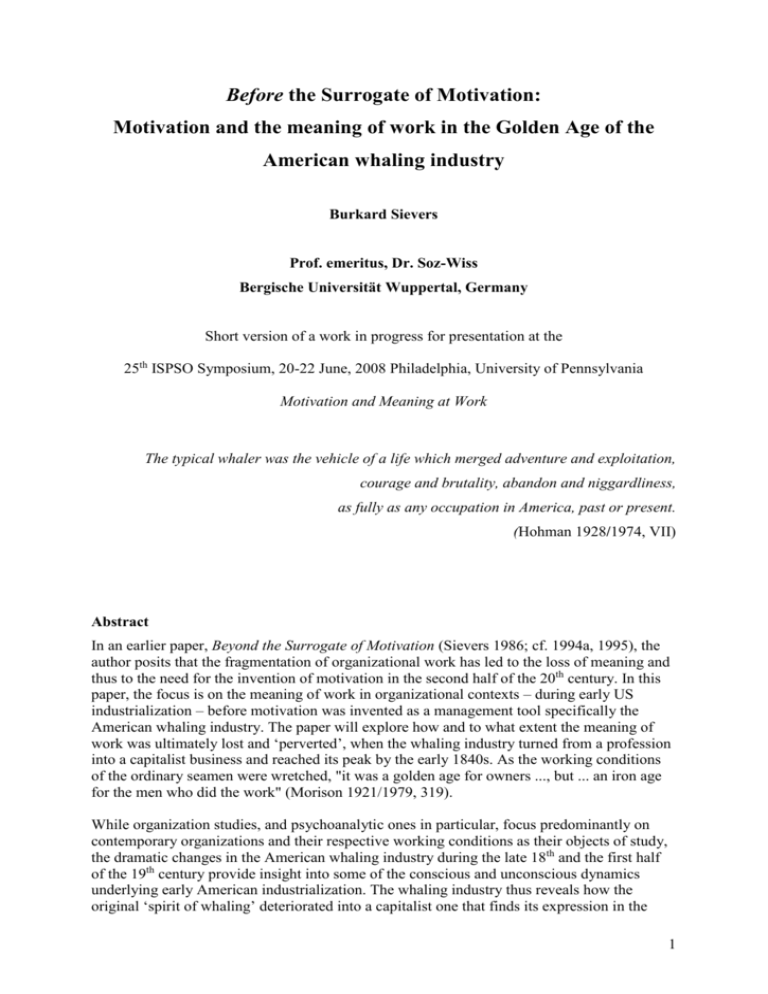
Before the Surrogate of Motivation: Motivation and the meaning of work in the Golden Age of the American whaling industry Burkard Sievers Prof. emeritus, Dr. Soz-Wiss Bergische Universität Wuppertal, Germany Short version of a work in progress for presentation at the 25th ISPSO Symposium, 20-22 June, 2008 Philadelphia, University of Pennsylvania Motivation and Meaning at Work The typical whaler was the vehicle of a life which merged adventure and exploitation, courage and brutality, abandon and niggardliness, as fully as any occupation in America, past or present. (Hohman 1928/1974, VII) Abstract In an earlier paper, Beyond the Surrogate of Motivation (Sievers 1986; cf. 1994a, 1995), the author posits that the fragmentation of organizational work has led to the loss of meaning and thus to the need for the invention of motivation in the second half of the 20th century. In this paper, the focus is on the meaning of work in organizational contexts – during early US industrialization – before motivation was invented as a management tool specifically the American whaling industry. The paper will explore how and to what extent the meaning of work was ultimately lost and ‘perverted’, when the whaling industry turned from a profession into a capitalist business and reached its peak by the early 1840s. As the working conditions of the ordinary seamen were wretched, "it was a golden age for owners ..., but ... an iron age for the men who did the work" (Morison 1921/1979, 319). While organization studies, and psychoanalytic ones in particular, focus predominantly on contemporary organizations and their respective working conditions as their objects of study, the dramatic changes in the American whaling industry during the late 18th and the first half of the 19th century provide insight into some of the conscious and unconscious dynamics underlying early American industrialization. The whaling industry thus reveals how the original ‘spirit of whaling’ deteriorated into a capitalist one that finds its expression in the 1 increasing alienation of the work force, its exploitation by ship-owners and captains alike and the exclusive pursuit of money and wealth by ship-owners. Foreword While a paper on American whaling may at first sight raise your curiosity, you may be wondering even more why it is being presented by a German author. My choice of this topic is based on a history that began more than 15 years ago when I read Herman Melville’s (1851/1967) Moby-Dick for the very first time. The book opened up a totally new world for me. Before I present some of the insights from my voyage through the seascape, I have to admit that my focus has shifted in a significant way since I first submitted the abstract for this paper. Revisiting my earlier studies (Sievers 1994b), I came to realize that they were somewhat based on an idealization of Nantucket, in so far as I wrongly regarded it as the homeland of the ‘spirit of whaling’. In actuality, since the middle of the 18th century, Nantucket became the leading agent in turning the whale fishery into a capitalist industry. I thus had to restrict my focus in the sense that the dramatic changes in the American whaling industry during the late 18th and first half of the 19th century provide significant insight into some of the conscious and unconscious dynamics underlying the working conditions during early American industrialization. Introduction In this paper, the focus is on the historic period before the surrogate of motivation was invented. I will explore how and to what extent the meaning of whaling work was ultimately lost and ‘perverted’ in this industry during the chosen period. I will begin with a brief overview on The History of the American Whaling Industry 1690-1850 Though “the history of whaling is a vast topic” (Forster 1985, XI), it seems that common knowledge about this history is often limited to what readers of Melville’s Moby-Dick (or mere fragments of it) have learned or grasped about Captain Ahab and his ship, the Pequod. Be that as it may, the scope of this paper can only be a sketch. I will restrict my focus here to the whaling ports of Nantucket and New Bedford, as they had the most significant impact on the development of the industry. 2 The whaling industry is considered the very first New England industry and marks the beginning of early American industrialization and the transformation from an agrarian to a capitalist society. But it also “symbolizes, and sets the pattern for, a new economic order in which nature is systematically exploited for profit” (Ruggiero 2002, 99). – Whaling is the industry that first incarnated “violence in the economy” (ibid., 102). Whaling as a business developed on Nantucket, which is on the east coast of Massachusetts, after English settlers bought a portion of this island from the Indians in 1659. Nantucketers had been engaged in codfishing since the early 1690s; shore whaling on the island peaked in 1726 and deep sea whaling had already begun with shorter voyages of two to four weeks in the mid-1720s. Longer whaling voyages, however, did not begin before the 1740s. Nantucket reached prosperity during the period 1740-1775. To the extent that Nantucket Indians were employed in whaling till 1763 (at which time they were nearly extinct due to an epidemic), they were servants and mere hands. There seems to be quite some evidence that the fate of the Indians both on the island and in the whaling industry presaged the way ordinary seamen would be treated during later periods of the industry. Nantucket whaling underwent dramatic changes during the period 1775-1830 and had to face economic setbacks, especially during the American Revolution of 1775–1783. Nantucket’s whaling fleet was renewed and grew steadily towards the turn of the century, not least due to an increase in the demand for oil for the domestic market. In the 1790’s, new whaling grounds opened up in the Pacific and required larger vessels, which went for extended voyages lasting eighteen to thirty-four months. New labor demands were met by the recruiting by Nantucket ship-owners of “ethnic groups new to the island, creating a more heterogeneous population and a more diverse class structure” (Byers 1987, 255). The War of 1812 caused a dramatic decrease in the number of whaling ships and brought the maritime enterprises to a virtual standstill. Between 1818 and 1822, however, the island whaling fleet expanded again to a remarkable extent. 3 Once New Bedford became the leading whaling port in the world and dominated the American industry in 1823, Nantucket whaling decreased. In the middle decades of the 19th century, during the Golden Age of the industry, whaling “became the third biggest business in Massachusetts, and the American fleet the largest in the world” (Creighton 1995, 6). At this time, “nearly 700 whaleships, carrying 20,000 men, might be found at sea in a given year“ (ibid., 16 – with reference to Hohman 1928/1974, 26). This industry came to a sudden end with the discovery of oil wells in Pennsylvania in 1859. Motivation and the Meaning of Work in the American Whaling Industry I now would like to elucidate, from a socioanalytic view (Bain 1999) and a contemporary perspective on management and organization, how motivation and meaning in the American whaling industry were interrelated. It will be shown how the meaning of work gradually changed from one of a calling and vocation to a mere struggle for survival. While 20th century literature on the whaling industry often explicitly refers to ‘management’ and ‘motivation’, it has to be kept in mind that these modern notions did not exist until after the end of the whaling industry. It appears that for a majority of Nantucketers the meaning of life and of work was highly integrated until the middle of the 18th century. Whaling served as a way to make a living despite the island’s restricted agricultural resources and thus contributed to the prosperity of the community. The business was inspired by a ‘spirit of whaling’ and going whaling was based on a calling. During the following period, the time between 1740 and 1820, Nantucket whaling underwent enormous technological and economic changes that turned the previous local business into an industry, driven increasingly by mercantile capitalism. The longer voyages and the larger size of vessels required by far many more seamen than were available from the island. The increased recruitment of off-islanders, of members of the maritime proletariat and often inexperienced poor and propertyless young men, who had little hope of a career and little chance for high earnings, contributed to turning the two-class employment system into a fundamental, often insurmountable split among the Nantucketers and the ‘foreigners’. This split was maintained and at the same time symbolized by the rigid separation of living 4 quarters. The ordinary sailors were quartered in the primitive and often shabby forecastle at the bow, while the captain and his mates took the comfortable and almost luxurious quarterdeck at the stern. Above all, however, it meant a stringent split of responsibility, power and authority between those in command, who represented the interests of the ship-owners, and those whose duty was to obey. Seamen were regarded as “a different sort of people” (Vickers & Walsh 2005, 233). Referring to a contemporary socioanalytic notion, Nantucketers and ordinary sailors had a very different ‘organization-in-the-mind’ (Armstrong 2005). For the Nantucketers it was based on their community life, the Quaker doctrine of equality and individualism, an authority of and respect for elders, and, not least, an orientation towards business and the market. While their ‘organization-in-the-mind’ included the belief that one could depend on those in authority, the organization-in-the-mind of the ordinary seamen was similar to that of the Isolatoes, as described by Melville (1851/1967, 108), i.e. “each Isolato living on a separate continent of his own”. As their notion of organization was based, if at all, on the model of the agrarian family, it must have been extremely difficult, if not impossible, for them to identify with that of the Nantucketers and those in command, in particular. Their dependency needs were not met and they felt exploited and betrayed. The ranks of captain and officers were exclusively reserved for Nantucketers. During the first two decades aboard a whaler and once they had made it to shipmaster, Nantucketers often became ship-owners, merchants or took leading roles in other departments of the island’s business. As whaling turned from a business and profession based on a calling to an industry, the work of whalers increasingly became dominated by the ‘spirit’ of capitalism and its inherent quest for money and profit. The meaning of work for the ordinary seaman was reduced to the economic value it provided ship-owners. “Whaling work was organized by the social and economic interests of men, not as they faced the sea from the bow of a ship but as they envisioned the voyage from the counting house” (Creighton 1995, 195). By the early 1840s, whaling "was a golden age for owners ..., but ... an iron age for the men who did the work" (Morison 1921, 319). 5 The general picture one gets from the various sources on American whaling during its most prosperous time is that more often than not "the whaleships were floating hells" (Wood 1925, X). This weighty image, originating from the light of the enormous fire of the try-works, the huge furnaces on deck for melting whale oil, during dark nights at sea, captures the essence of the extreme working conditions, the tyranny, the starvation and often enough even the deaths of common whalemen suffered in seemingly unending voyages. The lay-system – or what nowadays would be called payment scheme or incentives – was from the very beginning the predominant method by which the profits from a catch were divided amongst crew members. During the early times of shore whaling and the shorter period of off-shore voyages, the lay-system was based on individual competence, experience and the amount of work and resources provided for a catch. At that time it certainly was a pay-system that fostered cooperation, as the profit of a catch was given to the crew as a whole. “Yet by 1830, if not earlier, this cooperation had been perverted into a foul system of exploitation” (Morison 1921/1979, 319). The sailors lay, i.e. the percentage of the profit a sailor was supposed to receive, became smaller and smaller. “The device of the lay, with its tantalizing possibility of a lucky voyage, served [not only] to obscure the average earnings” (Hohman 1928/1972, 239, n. 12), but was also “disguised to look like profit sharing” (Malloy 1989, 57); it was a ‘motivation in disguise’. The meaning of motivation during the development of American whaling underwent significant changes. During the early period of whaling, it was for a young man from Nantucket quite natural to go to sea as a calling, because that was what his male relatives and neighbours did as a profession. He thus had the expectation of making a career and respectable earnings first on a whaler and subsequently in the whaling business on the island. His less fortunate contemporaries, however, more often than not were forced to accept a whale agent’s offer to sign on for a voyage for mere ‘material’ reasons, i.e. to find employment and earn money to avoid starvation or to support their families. The expansion of the industry forced whaling agents and ship-owners to recruit among the growing body of poor and propertyless young men. They thus had to ‘invent’ sufficient ’rewards’ and ‘incentives’ to ‘motivate’ young men to sign on for a voyage. Ordinary sailors and green- 6 hands in particular were motivated by promising earnings – which due to the perversion of the lay-system, seldom or never materialized. So far as motivation from a contemporary management perspective is concerned, it appears that management in the whaling industry did not require motivation once a whaler had set sail. At this time, long before the invention of ‘motivation as a surrogate for meaning’ (Sievers 1986; cf. 1994a, 1ff., 1995), and in the whaling industry in particular, it appears that it really did not matter whether seamen were motivated or not, so long as they were performing the required work. Being servants, they had to obey the command of their masters, i.e. the captain or his mates. The fact that a major portion of a whaler’s crew was hired as mere hands also leads to certain conclusions about the image of man underlying the whaling industry during its Golden Age. As “extracting economic value from the whale” was “the commanding .. motive of the journey” and all else was secondary (Marx 1964, 306), the lower ranks of the crew and thus the majority of the whaling work force was nothing more than a means to meet this ‘commanding motive’. The majority of crew members thus shared a similar fate as the earlier Nantucket Indians. Though conspicuously part of the human race, ordinary sailors and greenhands were often treated as subhuman creatures, like ‘Untermenschen’. More often than not they were held in check by tyrannical discipline and extreme brutality. Once a whaler was bound home after a more or less successful catch and no longer required all hands, it was not uncommon for these men to be hazed to such an extent that they felt forced to desert with the hope of employment on another vessel – but also with the result that they lost any claim to their lay. “The rate of desertion, probably the best available index of dissatisfaction” (Vickers 1985, 282), was quite significant by the middle of the 19th century. “A whaler on one of the interminable Pacific cruises was lucky to return with one-half of the original crew” (ibid.). The underlying notion of management in the whaling industry was coined by a ‘management of people – if not servants’. And from what has been described here about the underlying image of man in this industry, there is ample evidence that seamen had no obligation to manage or motivate themselves. They just had to accept that the only meaning their work had was to increase the earnings of their commanders and the wealth of the ship-owners. 7 The changing role of the captain also had an immense impact on the deterioration of the working conditions and the increasing brutality aboard the whalers. While the captain still remained the authority aboard his vessel during the Golden Age, he had widely lost authority, responsibility and autonomy due to his role as delegate of the ship-owners and whaling agents. In contrast to the captain’s predecessors, ship-owners and agents increased their request for profit and thus their pressure on the captain. Therefore captains tended to pass on this pressure to their crews. Attempting to avoid his own experience of dependency and weakness, the captain most likely projected it onto his crew and the lower ranks, in particular, who, due to their origin, low status and poor skills, were more than willing to introject it. Devilish discipline and brutality thus appeared to be the appropriate means by which the captain, both consciously and unconsciously, more often than not attempted to salvage his self-image and authority. It thus can be assumed that this contributed to a collusion of mutual contempt amongst the two classes of the crew. Brutality on whalers escalated to a previously unknown extent and became itself a social defence against annihilation and mortal anxieties. Though brutality mainly remained onesided, in the sense that it was the captain and his mates who exercised it towards the rest of the crew, there is ample evidence in the whaling literature that single sailors and crews rebelled against their oppressors. Revolts and even mutinies were not uncommon at this time; “the stories of brutality on whaling vessels are legion” (Davis, Gallman & Gleiter 1997, 196; cf. Vickers & Walsh 2005, 224; Hohman 1928/1974, 198f). Whaling has always been an extremely anxiety-loaded enterprise. “A whaleman, who claimed not to be afraid of battling against a sperm whale, or any other whale for that matter, was either damned fool or a liar” (Dolin 2007, 265). It seems, however, that in maritime society such fears “simply could not be expressed aloud. In a world where it was customary to go to sea, ... [they] were ultimately inadmissible” (Vickers & Walsh 2005, 144) – and ingrained into the social defences against anxiety inherent in the structure and the primary task of the business (Menzies 1960). “Although whaling is a rationalized, collective operation, based on a strict division of labor, it remains a bloody, murderous hunt” (Marx (1964, 296). Seamen had to mobilize violence in order to execute the deaths of their ‘game animals’. The word ‘brutal’ is actually derived from the Latin brutalis, meaning ‘animal’ and ‘unreasonable’. This may well have influenced 8 whalers to projectively identify the Leviathan with their own inner animalistic, unreasonable parts and their coarseness and ponderosity. Displacing their own ‘primitive’ feelings or ‘drives’ into the object of their hunt, whalers felt legitimized to treat their ‘victims’ with the brutality with which it had been identified. Displacing both their own brutality and the brutality experienced from their commanders into the whale and the hunt apparently was the only legitimate way it could be exercised and controlled – not only by the seamen themselves but in community with their captain and his mates. And as Melville (1851/1967), 41) states in Moby-Dick, "there is death in the business of whaling". "Death came, on the average, to one member of a crew during the course of each whaling voyage; and it came in a variety of forms. … In some guise death visited each crew, on the average, at least once" (Hohman 1928/1974, 68, cf. 183 ff.). And “the odds of dying young were strong” (Vickers & Walsh 2005, 144). That seamen commonly were regarded as hands indicates – in addition to its underlying image of man – the extent to which the image of organization, i.e. the vessel, is related to the image of the machine as the predominant one of early industrialization. “Between 1830 and 1860 the image of the machine, and the idea of the society founded upon machine power suddenly took hold of the public image” (Marx 1956, 30; cf. Mumford 1966). Like workers in the factories ashore from the beginning of 19th century, sailors were perceived as appendices of the machine and were “compelled .. to objectify themselves and others as abstract laborpower” (Sellers 1991, 153; cf. Marx 1956, 1964). Conclusion By now it may have become obvious that “the whaling industry symbolizes, and sets the pattern for, a new economic order in which nature is systematically exploited for profit” (Ruggiero 2002, 99). Though this exploitation is obvious for the objects of the most bloody, murderous hunt (Marx 1964, 296), i.e. the (sperm) whales, it also applies for its subjects, i.e. the whalemen. Not only did they become killers themselves, but as their bodies (and souls) were exploited, subjugated and dehumanized, these dynamics were irreversibly ingrained in the American whaling industry. It thus seems that the Golden Age of American whaling set the pattern for how the loss of meaning of whaling work was compensated by extreme brutality; to a large extent, violence became the surrogate for the loss of meaning. 9 In contrast to the work of small industries and factories in New England during the first half of the 19th century, the ‘factories’ of the whaling industry operated at sea. The sea not only caused extreme working and living conditions and permanently exposed whalers to sudden death; it also confronted them with the ongoing experience of the endless and infinite (cf. Lawrence 1999). It is, however, quite surprising that although the sea in psychoanalysis is the prominent symbol for the unconscious, this part of reality and its impact on whaling is very seldom – if at all – addressed in the vast whaling literature. It raises the question of what individually and collectively has not been explored about this industry and what shadow it cast on early American industrialization – and most likely on the way work is organized into the present. It is also clear that whaling scholars almost exclusively restricted their attention to the ‘material’ part of Moby-Dick and thus neglected its other aspect, the ‘spiritual’. Compared to Melville, who writes from the “bottomless ocean of truth” (Mumford 1929/1963, 159) and “no more forgets the aesthetics of whaling than he forgets the economics” (ibid., 171), it appears that a majority of later writers were content with the ‘gears and tackles’, the ‘years and decades’, the ‘pounds and barrels’, i.e. the ‘facts and figures’ of the industry. Though psychoanalysis as a discipline did not exist before the turn of the 20th century, Herman Melville (1851/1967), in Moby-Dick, gives convincing proof that the depth of the sea also reverberates in the depth of human experience. Melville was so much aware of it that he rightly ranks among those proto-psychoanalysts who addressed the unconscious long before it crystallised into a science. While Herman Melville “brought back into the petty triumphs of the age the one element that it completely lacked: the tragic sense of life: the sense that the highest human flight is sustained over an unconquered and perhaps unconquerable abyss” (Mumford 1929/1963, 4f.), my own reading of the whaling literature leaves me with the impression that, as T. S. Eliot (1974) famously wrote, “humankind cannot bear very much reality”. It seems that most ‘whaling scholars’ cannot bear “the tragic sense of life” very much either. References Armstrong, David (2005): Organization in the Mind. Psychoanalysis, Group Relations, and Organizational Consultancy. London: Karnac 10 Bain, Alastair (1999): On Socio-Analysis. Socio-Analysis 1, 1, 1-17 Byers, Edward (1987): The Nation of Nantucket: Society and Politics in an Early American Commercial Center, 1660-1820 (New England Studies). Boston: Northeastern University Press Creighton, Margaret S. (1995): Rites and Passages. The Experience of American Whaling, 830-1870. ISBN-13: 9780521484480 | ISBN-10: 0521484480 Davis, Lance E., Robert E. Gallman & Karin Gleiter (1997): In Pursuit of Leviathan: Technology, Institutions, Productivity, and Profits in American Whaling, 18161906. Chicago, Ill.: The University of Chicago Press Dolin, Eric Jay (2007): Leviathan: The History of Whaling. New York: W. W. Norton & Company Eliot, Thomas S. (1974): Murder in the Cathedral. London: Faber & Faber Forster, Honore (1985): The South Sea whaler: an annotated bibliography of published historical, literary, and art material relating to whaling in the Pacific Ocean in the nineteenth century. Sharon, Mass. : Kendall Whaling Museum ; Fairhaven, Mass.: E.J. Lefkowicz Hohman, Elmo Paul (1928/1974): The American Whaleman. A Study of Life and Labor in the Whaling Industry. New York: Longmans, Green & Co., reprint: London: Macdonald and Jane's Lawrence, W. Gordon (1999): Thinking Refracted in Organizations. The Finite and the Infinite / The Conscious and the Unconscious. Paper presented at the 1999 Symposium of The International Society for the Psychoanalytic Study of Organizations. Toronto. http://www.sba.oakland.edu/ispso/html/1999Symposium/Lawrence1999a.htm ; published as: Thinking Refracted. In: W. Gordon Lawrence (2000): Tongued with Fire: Groups in Experience. London: Karnac Books, 1-30 Malloy, Mary (1989): Whalemen's Perceptions of 'The High and Mighty Business of Whaling’. The Log of Mystic Seaport 41, 2, 56-67 Marx, Leo (1956): The Machine in the Garden. The New England Quarterly 29, 27-42 Marx, Leo (1964): The Machine in the Garden. Technology and the Pastoral Ideal in America. London: Oxford University Press Melville, Herman (1851/1967):Moby-Dick. Edited by Harrison Hayford & Hershel Parker. New York: Norton Menzies, Isabel E. P. (1960): A Case Study in the Functioning of Social Systems as a Defense Against Anxiety. Human Relations 13, 95-121 Morison, Samuel Eliot (1921/1979): The Maritime History of Massachusetts 1783 – 1860. Boston: Houghton Mifflin; reprint: (1979): Boston: Northeastern University Press Mumford, Lewis (1929/1963): Herman Melville. A Study of his Life and Vision. New York: The Literary Guild of America; reprint: London: Martin, Secker & Warburg Mumford, Lewis (1966): The Myth of the Machine: Technics and Human Development. New York: Harcourt Ruggiero, Vincenzo (2002): Moby Dick and the Crimes of the Economy. The British Journal of Criminology 42, 96-108 Sellers, Charles (1991): The Market Revolution: Jacksonian America, 1815-1846. New York: Oxford University Press Sievers, Burkard (1986): Beyond the surrogate of motivation. Organization Studies, 7, 335351 11 Sievers, Burkard (1994a): Work, Death, and Life Itself. Essays on Management and Organization. Berlin: de Gruyter Sievers, Burkard (1994b): In Search of Vengeance: Lessons on Management and Organization from Herman Melville’s Moby-Dick. Paper presented at the 12th International Conference of the Standing Conference on Organizational Symbolism (SCOS), Calgary, Alberta, Canada, July 10-13, 'Organizing the Past', Manuscript Sievers, Burkard (1995): Motivation as a Surrogate for Meaning. In: Linda Smircich & Marta B. Calás (eds.), Critical Perspectives on Organization and Management Theory. Aldershot: Dartmouth, 425-441 Vickers, Fredrick Daniel (1985): Nantucket Whalemen in the Deep-Sea Fishery: The changing anatomy of an early American Labor Force. The Journal of American History 72, 277-296 Vickers, Fredrick Daniel with Vince Walsh (2005): Young Men at Sea. Yankee seafarers in he age of sail. New haven & London: Yale University Press Wood, Frank (1925): Introduction. In: George Francis Dow, Whale Ships and Whaling. A Pictorial History. Salem. Mass: Marine Research Society [reprint 1985, New York: Dover] IX-XI The Author Dr. Burkard Sievers, Dipl. Soz., is Professor emeritus for Organization Development in the Department of Management and Economics at Bergische University Wuppertal in Germany. In his research he focuses on unconscious dynamics in management and organization from a socio-analytic and systemic perspective. In 1995, he was awarded the international price for participation by the HBK Bank in Antwerp, Belgium, for his book ‘Work, Death and Life Itself - Essays on Management and Organisation’ (Berlin/New York: de Gruyter 1994). He is Past-President (2007-2009) of the International Society for the Psychoanalytic Study of Organizations (ISPSO). Recent publications: Sievers, Burkard (2006): Psychotic Organization – A Socio-Analytic Perspective. ephemera 6 (2), 104-120 http://www.ephemeraweb.org/journal/6-2/6-2sievers.pdf Sievers, Burkard (2007): Pictures from below the Surface of the University: The Social Photo-Matrix as a Method for Understanding Organizations in Depth. In: Michael Reynolds & Russ Vince (eds.), Handbook of Experiential Learning and Management Education. Oxford (Oxford University Press), 241-257 Sievers, Burkard & Arndt Ahlers-Niemann (eds.) (2007): The Psychoanalytic Study of Organizations. A bibliography in the making. 2nd extended edition. Norderstedt: Books on Demand E-mail: sievers@wiwi.uni-wuppertal.de 12
